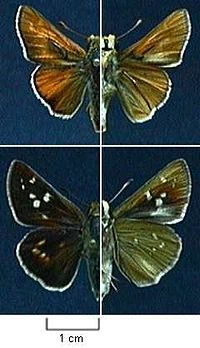Brief Summary
(
anglais
)
fourni par EOL authors
Leonard’s Skipper, Hesperia leonardus, is a late season species grass skipper (subfamily Hesperiinae) found over much of the northeastern United States south through the Atlantic states to North Carolina and Tennessee west to Oklahoma and Colorado. It is also found in Canada from Nova Scotia to Alberta. There are three rather distinct subspecies. The nominate subspecies, Hesperia l. leonardus is found in the eastern United States south to North Carolina and Tennessee west to Oklahoma and Missouri. It also occurs in southern Canada, the Great Lakes states and the upper Midwest. The hindwing below is dark brown or chestnut with a white or cream spotband. Both pairs of upper wings are dark brown or black with some irregular yellow bands which are more prominent in the female. The male has a black stigma. Pawnee Skipper, Hesperia l. pawnee is found from western Montana and southeastern Saskatchewan east to Minnesota , south to central Colorado and Kansas. The hindwing below is yellowish or orange with spots reduced or absent. The forewing above is orange with brown borders. At one time Pawnee Skipper was considered to be a separate species. However, intermediates between Hesperia l. leonardus and Hesperia l. pawnee have been found in the upper Midwest. Pawnee Montane Skipper, Hesperia l. montana, is found only in the South Platte River drainage of Colorado. Dorsally it is brown with cream spots. Above it is brownish red with yellow spots near the outer margins. Due to its ocurrence in a small area which is a single river drainage, Pawnee Montane Skipper is listed as Threatened by the USFWS. Nectar plants include thistles (Cirsium spp.), lobelias (Lobelia spp.), blazing stars (Liatris spp.) and asters. Larval foodplants are grasses including little bluestem (Schizachyrium scoparium), blue grama (Bouteloua gracilis) and bent grasses (Agrostis spp. ). Caterpillars eat the grass leaves and live in shelters of leaves tied together. First instar caterpillars hibernate. Throughout its range Leonard’s Skipper is single brooded. This species is often associated with high quality natural areas such as glades, barrens, oak savanna and prairies. Periodic fires are useful in maintaining the grassland habitat necessary for this species.
North American Ecology (US and Canada)
(
anglais
)
fourni par North American Butterfly Knowledge Network
Hesperia leonardus is a year-round resident of the north central- northeastern United States, and into southern Canada (Scott 1986). Habitats are woodland meadows and clearings, prairie, and open Ponderosa pine woodland on crumbling Pikes Peak Granite soil. Host plants are multiple species of grasses. Eggs are laid haphazardly on or near the host plant. Individuals overwinter as first instar larvae. There is one flight each year with the approximate flight time Aug. 15- early Sept. in the northern part of the range, late Aug.-Sept. 15 in the southern part of their range, and Sept. 15- early Oct. in Arkansas (Scott 1986).
Behavior
(
anglais
)
fourni par North American Butterfly Knowledge Network
Adults sip flower nectar, especially from Liatris punctata. Males both patrol and perch for females (Scott, 1986).
Hesperia leonardus: Brief Summary
(
anglais
)
fourni par wikipedia EN
Hesperia leonardus, the Leonard's skipper, is a butterfly of the family Hesperiidae. There are three subspecies. Next to the nominate species, these are the Pawnee skipper (ssp. pawnee), which is found in North America from western Montana and south-eastern Saskatchewan east to Minnesota, south to central Colorado and Kansas. Leonard's skipper ranges from Nova Scotia and Maine west through southern Ontario and the Great Lakes region to Minnesota, south to North Carolina, Louisiana and Missouri and the Pawnee montane skipper (ssp. montana) is endemic to the South Platte River drainage of Colorado.

Hesperia leonardus museum specimen

H. l. pawnee
The wingspan is 32–45 mm. There is one generation with adults on wing from August to October.
The larvae feed on various grasses, including Andropogon scoparius, Bouteloua gracilis, and Agrostis. Adults feed on flower nectar from various flowers, including Liatris punctata, thistles, asters, and teasel.
- licence
- cc-by-sa-3.0
- droit d’auteur
- Wikipedia authors and editors



 Hesperia leonardus museum specimen
Hesperia leonardus museum specimen  H. l. pawnee
H. l. pawnee